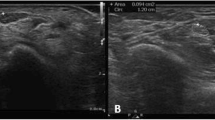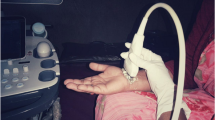Abstract
The aim of this work was to evaluate the diagnostic performance of grey-scale, color Doppler, and dynamic ultrasound (US) for diagnosing carpal tunnel syndrome (CTS) using the medical diagnostic test called nerve conduction study (NCS) as the reference standard, and to correlate the increase in median nerve (MN) cross-sectional area (CSA) with severity of CTS. Fifty-one patients (95 wrists) with clinical symptoms of idiopathic CTS were recruited. The CSA and flattening ratio of the MN were measured at the distal radio-ulnar joint, pisiform, and hamate levels; bowing of the flexor retinaculum was determined at the hamate level. The hypervascularity of the MN was evaluated. The transverse sliding of the MN was observed dynamically and recorded as being either normal or restricted/absent. Another 15 healthy volunteers (30 wrists) were recruited as controls. Interoperator reliability was established for all criteria. CTS was confirmed in 75 wrists (75/95: 79 %; 14 minimal, 21 mild, 23 moderate, 17 severe). CSA at the pisiform level was found to be the most reliable and accurate grey-scale criterion to diagnose CTS (optimum threshold: 9.8 mm2). There was a good correlation between the severity of NCS and CSA (r = 0.78, p < 0.001). The sensitivity and specificity of color-Doppler and dynamic US in detecting CTS was 69, 95, 58, and 86 %, respectively. Combination of these subjective criteria with CSA increases the sensitivity to 98.3 %. US measurement of CSA provides additional information about the severity of MN involvement. Color-Doppler and dynamic US are useful supporting criteria that may expand the utility of US as a screening tool for CTS.





Similar content being viewed by others
References
de Krom MC, Knipschild PG, Kester AD, Thijs CT, Boekkooi PF, Spaans F. Carpal tunnel syndrome: prevalence in the general population. J Clin Epidemiol. 1992;45:373–6.
Peetrons PA, Derbali W. Carpal tunnel syndrome. Semin Musculoskelet Radiol. 2013;17:28–33.
Buchberger W, Schon G, Strasser K, Jungwirth W. High-resolution ultrasonography of the carpal tunnel. J Ultrasound Med. 1991;10:531–7.
Beekman R, Visser LH. Sonography in the diagnosis of carpal tunnel syndrome: a critical review of the literature. Muscle Nerve. 2003;27:26–33.
Leonard L, Rangan A, Doyle G, Taylor G. Carpal tunnel syndrome—is high-frequency ultrasound a useful diagnostic tool? J Hand Surg (Edinburgh, Scotland). 2003;28:77–9.
Wong SM, Griffith JF, Hui AC, Lo SK, Fu M, Wong KS. Carpal tunnel syndrome: diagnostic usefulness of sonography. Radiology. 2004;232:93–9.
Klauser AS, Halpern EJ, De Zordo T, et al. Carpal tunnel syndrome assessment with US: value of additional cross-sectional area measurements of the median nerve in patients versus healthy volunteers. Radiology. 2009;250:171–7.
Mallouhi A, Pulzl P, Trieb T, Piza H, Bodner G. Predictors of carpal tunnel syndrome: accuracy of gray-scale and color-Doppler sonography. AJR Am J Roentgenol. 2006;186:1240–5.
Nakamichi K, Tachibana S. Restricted motion of the median nerve in carpal tunnel syndrome. J Hand Surg (Edinburgh, Scotland). 1995;20:460–4.
Sarria L, Cabada T, Cozcolluela R, Martinez-Berganza T, Garcia S. Carpal tunnel syndrome: usefulness of sonography. Eur Radiol. 2000;10:1920–5.
Keles I, Karagulle Kendi AT, Aydin G, Zog SG, Orkun S. Diagnostic precision of ultrasonography in patients with carpal tunnel syndrome. Am J Phys Med Rehabil. 2005;84:443–50.
Karadag YS, Karadag O, Cicekli E, et al. Severity of carpal tunnel syndrome assessed with high-frequency ultrasonography. Rheumatol Int. 2010;30:761–5.
Altinok T, Baysal O, Karakas HM, et al. Ultrasonographic assessment of mild and moderate idiopathic carpal tunnel syndrome. Clin Radiol. 2004;59:916–25.
El Miedany YM, Aty SA, Ashour S. Ultrasonography versus nerve conduction study in patients with carpal tunnel syndrome: substantive or complementary tests? Rheumatology (Oxford). 2004;43:887–95.
Jablecki CK, Andary MT, So YT, Wilkins DE, Williams FH. Literature review of the usefulness of nerve conduction studies and electromyography for the evaluation of patients with carpal tunnel syndrome. AAEM quality assurance committee. Muscle Nerve. 1993;16:1392–414.
Witt JC, Hentz JG, Stevens JC. Carpal tunnel syndrome with normal nerve conduction studies. Muscle Nerve. 2004;29:515–22.
Seror P. Sonography and electrodiagnosis in carpal tunnel syndrome diagnosis, an analysis of the literature. Eur J Radiol. 2008;67:146–52.
Ooi CC, Png MA, Tan BHA, et al. Diagnostic criteria of carpal tunnel syndrome using high-resolution ultrasonography. Skeletal Radiol. 2013;42:886–7.
Martinoli C, Bianchi S, Gandolfo N, Valle M, Simonetti S, Derchi LE. US of nerve entrapments in osteofibrous tunnels of the upper and lower limbs. Radiographics 2000; 20 Spec No: S199–213; discussion S213–197
Ziswiler HR, Reichenbach S, Vogelin E, Bachmann LM, Villiger PM, Juni P. Diagnostic value of sonography in patients with suspected carpal tunnel syndrome: a prospective study. Arthritis Rheum. 2005;52:304–11.
Bayrak IK, Bayrak AO, Tilki HE, Nural MS, Sunter T. Ultrasonography in carpal tunnel syndrome: comparison with electrophysiological stage and motor unit number estimate. Muscle Nerve. 2007;35:344–8.
Beekman R, Visser LH. High-resolution sonography of the peripheral nervous system—a review of the literature. Eur J Neurol. 2004;11:305–14.
Chen SF, Lu CH, Huang CR, et al. Ultrasonographic median nerve cross-section areas measured by 8-point “inching test” for idiopathic carpal tunnel syndrome: a correlation of nerve conduction study severity and duration of clinical symptoms. BMC Med Imaging. 2011;11:22.
Dejaco C, Stradner M, Zauner D, et al. Ultrasound for diagnosis of carpal tunnel syndrome: comparison of different methods to determine median nerve volume and value of power Doppler sonography. Ann Rheum Dis. 2013;72:1934–9.
Mohammadi A, Ghasemi-Rad M, Mladkova-Suchy N, Ansari S. Correlation between the severity of carpal tunnel syndrome and color Doppler sonography findings. AJR Am J Roentgenol. 2012;198:W181–4.
Naranjo A, Ojeda S, Mendoza D, Francisco F, Quevedo JC, Erausquin C. What is the diagnostic value of ultrasonography compared to physical evaluation in patients with idiopathic carpal tunnel syndrome? Clin Exp Rheumatol. 2007;25:853–9.
Hunter JM. Recurrent carpal tunnel syndrome, epineural fibrous fixation, and traction neuropathy. Hand Clin. 1991;7:491–504.
Korstanje JW, Scheltens-De Boer M, Blok JH, et al. Ultrasonographic assessment of longitudinal median nerve and hand flexor tendon dynamics in carpal tunnel syndrome. Muscle Nerve. 2012;45:721–9.
Padua L, Pazzaglia C, Caliandro P, et al. Carpal tunnel syndrome: ultrasound, neurophysiology, clinical and patient-oriented assessment. Clin Neurophysiol. 2008;119:2064–9.
Duncan I, Sullivan P, Lomas F. Sonography in the diagnosis of carpal tunnel syndrome. AJR Am J Roentgenol. 1999;173:681–4.
Acknowledgments
The authors wish to thank Ms. Sally Lee for her invaluable assistance in statistical analysis. This study was supported by SGH Research Grant (Grant number: SRG #04/2011).
Conflict of interest
The authors declare that they have no conflicts of interest.
Author information
Authors and Affiliations
Corresponding author
Electronic supplementary material
Below is the link to the electronic supplementary material.
ESM 1
(PDF 22 kb)
Rights and permissions
About this article
Cite this article
Ooi, C.C., Wong, S.K., Tan, A.B.H. et al. Diagnostic criteria of carpal tunnel syndrome using high-resolution ultrasonography: correlation with nerve conduction studies. Skeletal Radiol 43, 1387–1394 (2014). https://doi.org/10.1007/s00256-014-1929-z
Received:
Revised:
Accepted:
Published:
Issue Date:
DOI: https://doi.org/10.1007/s00256-014-1929-z




